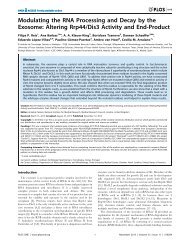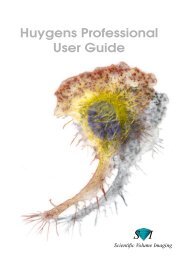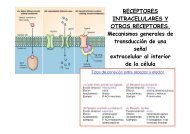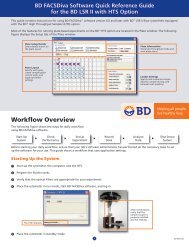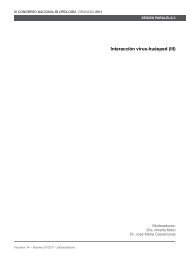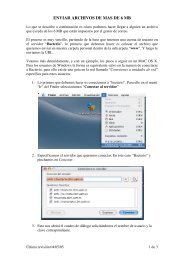Drosophila - Severo Ochoa - Universidad Autónoma de Madrid
Drosophila - Severo Ochoa - Universidad Autónoma de Madrid
Drosophila - Severo Ochoa - Universidad Autónoma de Madrid
Create successful ePaper yourself
Turn your PDF publications into a flip-book with our unique Google optimized e-Paper software.
Jefe <strong>de</strong> Línea /<br />
Group Lea<strong>de</strong>r:<br />
Fernando Jiménez Díaz-Benjumea<br />
Comunicación intercelular<br />
en el <strong>de</strong>sarrollo<br />
Cell-cell signalling in <strong>de</strong>velopment<br />
A6<br />
Tesis doctorales<br />
Doctoral Theses<br />
Resumen <strong>de</strong> investigación<br />
Research summary<br />
Javier Terriente Félix. (2006). Análisis functional <strong>de</strong>l gen nab<br />
en el <strong>de</strong>sarrollo <strong>de</strong> <strong>Drosophila</strong> melanogaster.<br />
Becarios Predoctorales /<br />
Predoctoral Fellows:<br />
Javier Terriente Félix<br />
Daniel Perea Menén<strong>de</strong>z<br />
Biología <strong>de</strong>l Desarrollo Developmental Biology<br />
En los organismos multicelulares la comunicación<br />
intercelular <strong>de</strong>termina el comportamiento <strong>de</strong> las células<br />
durante el <strong>de</strong>sarrollo. Esta comunicación está mediada por<br />
un reducido número <strong>de</strong> rutas <strong>de</strong> señalización que se usa <strong>de</strong><br />
forma reiterada en diferentes estadios y tejidos. No obstante<br />
su activación genera diferentes resultados según el<br />
contexto celular. Nuestro objetivo es enten<strong>de</strong>r cómo estas<br />
rutas <strong>de</strong> señalización controlan la proliferación celular y la<br />
formación <strong>de</strong> patrones morfológicos durante el <strong>de</strong>sarrollo y<br />
cómo el contexto celular <strong>de</strong>termina la respuesta <strong>de</strong> las<br />
células. Se ha observado que los componentes <strong>de</strong> estas<br />
rutas así como sus relaciones moleculares están muy<br />
conservados en diferentes organismos <strong>de</strong>s<strong>de</strong> artrópodos<br />
hasta mamíferos. Ello sugiere que resultados obtenidos en el<br />
análisis <strong>de</strong>l <strong>de</strong>sarrollo <strong>de</strong> sistemas experimentales sencillos<br />
pue<strong>de</strong>n tener vali<strong>de</strong>z en organismos más complejos.<br />
Los apéndices son un sistema mo<strong>de</strong>lo para el estudio <strong>de</strong>l<br />
<strong>de</strong>sarrollo. El análisis genético y molecular llevado a cabo<br />
en diferentes organismos ha permitido establecer las reglas<br />
básicas <strong>de</strong> cómo se controla el <strong>de</strong>sarrollo <strong>de</strong> los apéndices<br />
en artrópodos y en vertebrados. Aunque éstos no son<br />
estructuras homólogas, su <strong>de</strong>sarrollo presenta muchas<br />
similitu<strong>de</strong>s. El <strong>de</strong>sarrollo <strong>de</strong>l ala <strong>de</strong> <strong>Drosophila</strong> se lleva a<br />
cabo mediante la acción integrada <strong>de</strong> dos centros<br />
organizadores que controlan el <strong>de</strong>sarrollo en los ejes A/P y<br />
D/V. La actividad y la ubicación <strong>de</strong> estos centros<br />
organizadores está mediada por las rutas <strong>de</strong> Hh, Dpp<br />
(TGFβ), Notch y Wingless (Wg/WNT). Los mecanismos por<br />
los que se controla el <strong>de</strong>sarrollo en el eje Pr/D son menos<br />
conocidos. Con este objetivo hemos abordado el análisis <strong>de</strong><br />
genes implicados en el <strong>de</strong>sarrollo Pr/D <strong>de</strong>l ala. El gen nab<br />
es uno <strong>de</strong> ellos. Nuestros resultados indican que nab se<br />
requiere para restringir la expresión <strong>de</strong> wg a un anillo <strong>de</strong><br />
células en la región proximal <strong>de</strong>l apéndice, don<strong>de</strong> wg tiene<br />
una función mitogénica. Nab actua como cofactor <strong>de</strong><br />
Rotund, un factor <strong>de</strong> transcripción requerido para la<br />
activación <strong>de</strong> wg.<br />
In multicellular organisms, cell-cell communication governs<br />
cell behaviour in <strong>de</strong>velopment. A reduced number of<br />
signalling pathways are repeatedly used in <strong>de</strong>velopment at<br />
different times and tissues. Nevertheless their activation<br />
gives rise to different cellular responses <strong>de</strong>pending on the<br />
cellular context. Our goal is to un<strong>de</strong>rstand how these<br />
signalling pathways work in controlling cell proliferation and<br />
pattern formation during <strong>de</strong>velopment and how the cellular<br />
context <strong>de</strong>termines the response of the cells. The<br />
components of these pathways and their molecular<br />
relationships are very conserved in different organisms,<br />
ranging from arthropods to mammals. This suggests that the<br />
conclusions obtained in the study of simpler experimental<br />
mo<strong>de</strong>ls can be applied in more complex organisms.<br />
Appendages are a mo<strong>de</strong>l system for the study of<br />
<strong>de</strong>velopment. The genetic and molecular analyses carried<br />
out in different organisms have allowed establishing the<br />
basic rules that govern appendage <strong>de</strong>velopment in both<br />
vertebrates and arthropods. Although vertebrate limbs and<br />
arthropod appendages are not homologous structures their<br />
<strong>de</strong>velopment present many similarities. The <strong>de</strong>velopment of<br />
the <strong>Drosophila</strong> wing is governed by the integrated action of<br />
two organizing centres which control the <strong>de</strong>velopment of the<br />
wing in the A/P and D/V axes. The activity and the location<br />
of these organizing centres are mediated by the Hh, Dpp<br />
(TGFβ), Notch and Wingless (Wg/WNT) signalling pathways.<br />
The mechanisms that drive the <strong>de</strong>velopment in the Pr/D axis<br />
of the wing are less known. We have carried out the analysis<br />
of genes involved in the <strong>de</strong>velopment of the Pr/D axis of the<br />
wing. The gene nab is one of them. Our results suggest that<br />
nab is required to <strong>de</strong>limit the expression of wg to a narrow<br />
ring of cells in the wing hinge, where wg has a mitogenic<br />
function. Nab acts as a cofactor of Rotund, a zinc-finger<br />
transcription factor required for the activation of wg<br />
expression in the wing hinge.<br />
Figura 1. Disco imaginal <strong>de</strong> ala <strong>de</strong> <strong>Drosophila</strong> mostrando<br />
los patrones <strong>de</strong> expresión <strong>de</strong> los genes tsh (rojo),<br />
zfh2 (ver<strong>de</strong>) y nab (azul).<br />
Figure 1. A <strong>Drosophila</strong> wing imaginal disc showing tsh (red),<br />
zfh2 (green) and nab (blue) expression patterns.<br />
Figura 2. Vistas ventral y lateral <strong>de</strong> dos embriones <strong>de</strong> <strong>Drosophila</strong><br />
mostrando los patrones <strong>de</strong> expression <strong>de</strong> los genes nab (rojo)<br />
y sqz (ver<strong>de</strong>).<br />
Figure 2. Ventral and lateral views of <strong>Drosophila</strong> embryos showing<br />
nab (red) and sqz (green) expression patterns.<br />
CBM 2005/2006<br />
28<br />
29



